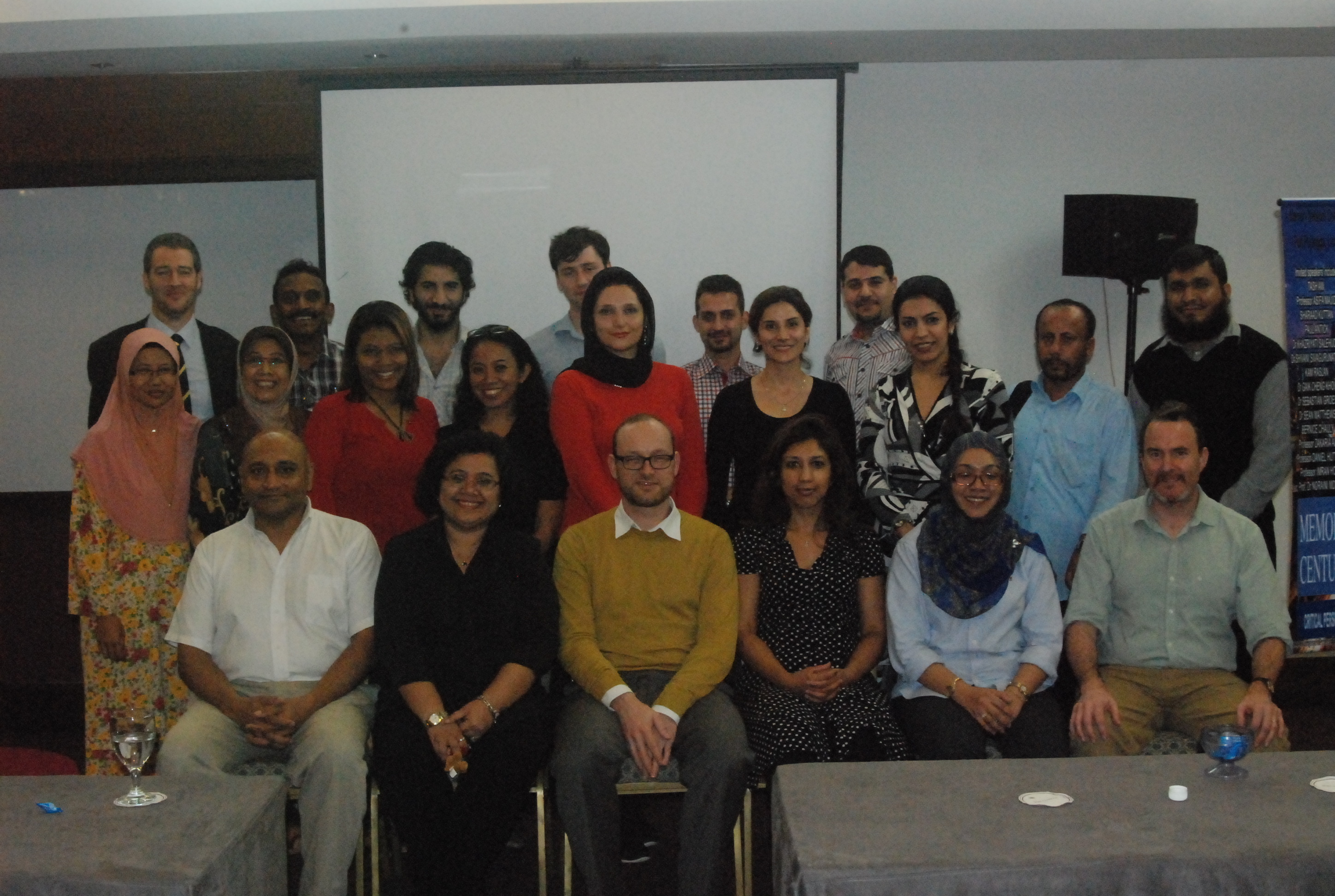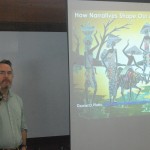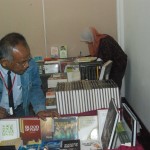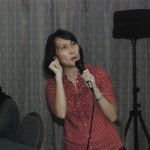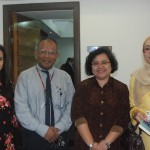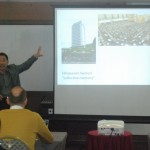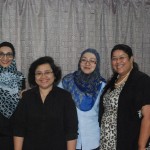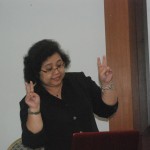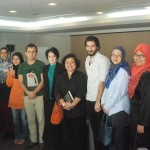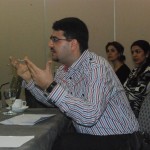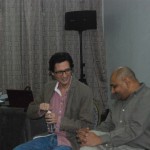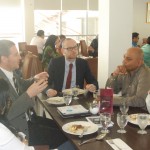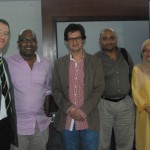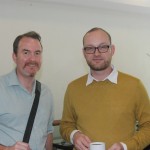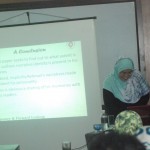-Ruzy Hashim
Memory in Twenty-First Century Malaysia: Critical Perspectives from the Arts, Humanities and the Sciences conference was held on 12-13 December 2013 at Universiti Kebangsaan Malaysia. The conference was a good mix of research presentations, literary readings, a forum and research resolutions. Jointly organised by Universiti Kebangsaan Malaysia, University of Roehampton, and the University of Nottingham, the gathering of people brought researchers, writers, and literary enthusiasts together.
As keynote speakers, Asifa Majid and Daniel Hutto delivered papers which provided insights into the practical and theoretical aspects of memory. In her paper entitled ‘Language and Memory for Twenty-First Century Malaysia,’ Majid considered what language can tell us about the underlying conceptualisation and corresponding memory of simple perceptual sensations. By showing linguistic data from different communities around the world – varying in subsistence mode (hunter-gatherer to industrial), ecological zone (rainforest jungle to desert) and dwelling type (rural and urban) – she illustrated the considerable variation found regarding how sensations and experiences are linguistically coded. In his paper entitled ‘How Narratives Shape Our Memories’, Hutto examined the possibility that personal and cultural narratives play a powerful, pivotal role in shaping what we remember – and that they do so in ways which matter fundamentally to our sense of who we are.
Papers with strong linguistic slant focus on the ways in which second language learning and memory. In their paper on ‘Influence of Prior Knowledge on Listening Input,’ Ernisa Marzuki and Ahmed Shamsul Bahri spoke about how learners recall specific items based on an experiment measuring the level of specific item recall in participants after listening to an altered version of a well-known local Sarawak folktale. The paper also examined the differences in the retention of participants who possessed prior knowledge of the narrative compared with those who did not have prior knowledge. Another interesting paper by Imran Ho Abdullah showed a cognitively-oriented analysis of two lexemes relating to remembering and memory – Ingat and Kenang – and their various morphological forms – ingat, mengingati, terkenang, teringat, mengenang (to remember), mengingatkan (to remind), ingatan, and kenangan (memory). By drawing from a corpus of Hansard Parliamentary reports (2013), he established a semantic profile of the two lexemes. His analysis reveals the sense distinction of the two lexemes as well as different facets of Malay, namely memory as thought, memory as reminder and memory as recollections in contemporary Parliamentary Discourse.
Papers that drew on the ways in which writers appropriated historical events provided insights into various forms of revisioning. In her paper on ‘Memory, Re-memory, Postmemory in Growing up with Ghosts’, Raihanah M.M. spoke about Bernice Chauly’s patrio/matriographic memoir that recounts the paternal and maternal history of her Chinese and Punjabi ancestries. Written as a multi-genre, multi-vocal narrative, the filial memoir contains testimonies that oscillate between the personal/private and the public, creating a manuscript that demands of readers that they suffer a phantom pain of loss and trauma along with the memoirist. The collection of episodic and semantic memory is thus akin to a ‘traumatic realist project’, one which documents events that ‘belongs to the past… but whose effects belong both to the present and the future.’ Anita Harris’s ‘Transgenerational Haunting and Transgression In Preeta Samarasan’s Evening is The Whole Day’ highlighted the novel’s relation to events of collective trauma such as May the 13th 1969, and examined the juxtaposition of Gothic narrative strategies with arch, ornate language that frames the unfolding of events transpiring in a house crammed with Gothicised elements, from the supernatural (in the form of a ghost) to the transgressive (incest and murder). The Gothic strategies, Harris argues, underscore the sense of transgenerational loss and the attempt of a millennial diasporic Malaysian writer to connect to a not-too-distant past in order to understand the cultural politics of the present. Similarly, Atiqah Amran drew our attention to May 13th in two novels written by diasporic Malaysians. Rani Manicka’s The Rice Motherand Tan Twan Eng’s The Garden of Evening Mistsdemonstrate different ways of re-telling history to recreate the trauma in a way that makes a compelling case of inquiry of Malaya’s history from 1941 to 1945. Atiqah showed that the novelists shift the historical consciousness that allows reconciliation to the representation and interpretation of history while maintaining an episodic structure within the narration.
Papers which dealt with psychogeography were also illuminating. Anis Ibrahim talked about walking in Kuala Lumpur and capturing the sights and sounds of the city, while Paul Antick went further afield into Batang Kali, Perak where a massacre by British soldiers of 24 rubber tappers at the Sungei Remok plantation occurred in 1948. By combining prosaic and photographic narratives, Antick re-imagined the way in which the old and new accounts merge.
Other interesting papers include Sebastian Groes’ examination of what he calls the ‘Literature of the Rising Powers’, twenty-first century fiction published by writers working in countries with booming economies or in newly industrialising nations, including India, Brazil, Malaysia, Pakistan, China, South Korea, Indonesia, Thailand, Vietnam, the Philippines and Singapore. In another paper, Shahizah Ismail Hamdan discussed ‘Malaysian Science Fiction Short Stories’, through which she examined how memories of Kuala Lumpur, the capital city, are manifested fifty years into the future. Noraini Md, Yusof’s presentation described her own creative process through, taking us through the development of a short story published in an anthology. She showed how snippets of her childhood memories were selected, why some events were re-told and others remained forgotten in the narrative. She highlighted the idea that creative license coalesces the actual events and people into forms of fabrication in her short stories, and that the re-telling of the memory may be so fictionalized that sometimes the story deviates from the actual.
The highlight of the conference was a series of readings by a number of Malaysian contemporary writers. Zakaria Ali read his poems inspired by his own paintings, Bernice Chauly read excerpts of her memoir Growing up with Ghosts, Kam Raslan delivered snippets of his work and Shivani Sivagurunathan gave us a treat by reading a short story which she had just finished writing.
The conference concluded with a discussion of ideas for future memory conferences and collaborative research projects. Various grants such as the Fundamental Research Grant Scheme and Transdisciplinary Research Grant Scheme from the Malaysian Ministry of Education provide funding for cutting edge projects. The nexus of humanities and sciences, as this memory conference has shown, is an area that requires further exploration. The Malaysian memory conference may be the impetus that triggers further collaborations to take place in the future.

